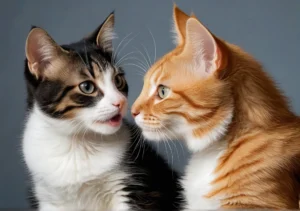Cats hissing at human babies can be a confusing and unsettling experience for many pet owners. It’s important to understand why this behavior occurs to ensure the safety of both your cat and your child. Read on to discover the reasons behind this common feline response.
When cats hiss at human babies, it’s often a sign of fear or anxiety. This natural reaction can be triggered by the baby’s sudden movements, loud noises, or unfamiliar scents. By understanding the underlying causes of this behavior, you can take steps to help your cat feel more comfortable around your little one.
Feline Instincts: Why Do Cats Hiss?
Cats hiss at human babies due to their natural instincts to protect themselves and assert dominance. Cats are extremely sensitive to changes in their environment and may perceive a new baby as a threat. The hissing is a warning signal that the cat feels uncomfortable and is setting boundaries.
Additionally, cats have a strong sense of smell and may be reacting to unfamiliar scents associated with the baby. As predators by nature, cats are cautious around vulnerable beings, such as human babies, and hissing is a way for them to communicate their discomfort.
It’s essential to understand and respect your cat’s instincts when introducing a baby into your home. Ensuring a gradual transition and providing your cat with a safe space to retreat to can help reduce their stress and minimize hissing behavior.
To further ease the introduction process, consider using calming pheromone diffusers or treats to create a positive association with the baby’s presence. Remember, patience and understanding are key when navigating this transition for both your feline friend and your new bundle of joy.
Creating a Safe Environment
Introduce Them Slowly: When bringing a new baby home, allow your cat to adjust gradually. Give them time to explore the baby’s scent and presence from a safe distance before any direct interactions.
Provide Vertical Space: Cats feel secure when they have vertical space to retreat to. Invest in cat trees or shelves where your cat can observe the baby from a safe distance.
Establish Boundaries: Set boundaries to ensure that your cat has their own space away from the baby’s reach. This can help prevent potential confrontations and reduce the likelihood of hissing incidents.
Supervise Interactions: Always supervise interactions between your cat and the baby. This will allow you to intervene if needed and prevent any negative interactions from escalating.
Seek Professional Help: If your cat’s hissing behavior persists or escalates, consider consulting a professional animal behaviorist for personalized advice and guidance on how to create a harmonious environment for both your cat and your baby.
By creating a safe and comfortable environment for your cat and your baby, you can help foster a peaceful coexistence and a loving bond between them. Remember, patience, understanding, and proper supervision are key in ensuring a positive relationship between your feline companion and your newest family member.
Socialization Strategies
Introducing a new baby to your feline friend can be a challenging process, but with the right strategies, you can help your cat adjust smoothly. Start by creating positive associations between the baby and your cat by giving them treats or toys when they are near each other. Make sure your cat has a safe space to retreat to if they feel overwhelmed, like a cozy spot on a high shelf or a separate room. Gradually increase the amount of time your cat spends around the baby, always supervising their interactions. This slow introduction can help your cat feel more comfortable and reduce their likelihood of hissing at the baby.
Signs of Stress in Cats
Understanding your cat’s body language is crucial in identifying signs of stress. Look out for dilated pupils, flattened ears, a twitching tail, or excessive grooming as indications that your cat may be feeling anxious or overwhelmed. If your cat is hissing at the baby, it could be a sign of stress or discomfort. Providing your cat with plenty of hiding spots, vertical spaces to climb, and interactive toys can help alleviate their stress and reduce the likelihood of hissing behavior. Additionally, consider using pheromone sprays or diffusers to create a calming atmosphere for your cat.
Helpful Tip: Regular play sessions and positive reinforcement can help your cat associate the presence of the baby with pleasant experiences, reducing tension and promoting harmonious interactions.
(For additional resources on cat behavior and stress management, consider consulting with a professional veterinarian or animal behaviorist.)
Introducing Cats and Babies
Welcoming a new baby into your home is an exciting time, but it can also be a challenging adjustment for your feline friend. Cats are creatures of habit and can sometimes feel stressed or threatened by this new addition to the family, leading them to hiss at human babies. It’s important to take steps to introduce your cat to your baby gradually and ensure a smooth transition for everyone involved.
One key tip is to provide your cat with a safe space where they can retreat to when they feel overwhelmed. This could be a cozy bed in a quiet room or a tall cat tree where they can observe from a distance. Gradually allow your cat to explore the baby‘s scent and sounds from a safe distance, always supervising their interactions closely.
Remember that positive reinforcement is key when introducing your cat and baby. Reward your cat with treats and affection when they approach the baby calmly, and never force interactions. With time and patience, your cat will adjust to the new addition and hissing behavior may decrease.
Seeking Professional Help
While it’s normal for cats to feel stressed when introduced to a new baby, consistent hissing or aggressive behavior should not be ignored. If your cat continues to hiss at human babies despite your best efforts, it may be time to seek professional help.
A veterinarian or animal behaviorist can help identify the root cause of your cat‘s hissing behavior and develop a custom behavior modification plan to address it. They can also provide tips on how to safely manage interactions between your cat and baby while working on changing negative associations.
Remember, your cat’s well-being is just as important as your baby’s, so don’t hesitate to seek professional help if needed. With the right support, you can create a harmonious relationship within your family.
Training Techniques
It’s essential to introduce positive reinforcement techniques when training your cat to interact with your baby. Reward good behavior, such as calmly approaching the baby, with treats or praise. Consistency is key in training; set aside dedicated time each day to work on this. Redirect negative behavior like hissing by gently distracting your cat with a toy or a treat. Gradually increase exposure between your cat and the baby, always under supervision, to help them get used to each other’s presence. Remember, patience and positive reinforcement go a long way in shaping your cat’s behavior towards your little one.
Fun Facts About Feline Behavior
- Scent Recognition: Cats rely heavily on scent to recognize their surroundings, and a new scent, like that of a baby, can trigger hissing as a defensive mechanism.
- Territorial Instincts: Cats are naturally territorial animals, and seeing a new addition to the household may cause them to feel threatened, leading to hissing behavior.
- Stress Reaction: Cats are highly sensitive creatures and can react through hissing when they feel stressed or overwhelmed by a new and unfamiliar presence.
- Motherly Instincts: Some cats may hiss at babies as a protective measure, especially if they perceive the infant as a potential threat to their territory or young.
By understanding these feline instincts and behaviors, you can better address why your cat may be hissing at your baby. Remember, creating a calm and safe environment for both your cat and child is crucial in fostering a harmonious relationship between them.
Alex, a passionate animal lover, has experience in training and understanding animal behavior. As a proud pet parent to two dogs and three cats, he founded AnimalReport.net to share insights from animal experts and expand his knowledge of the animal kingdom.




